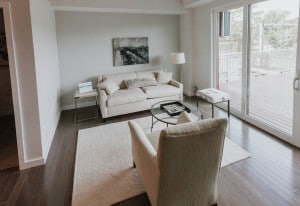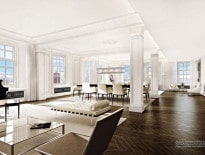Newly built or renovated multifamily developments set in urban environments attract tenants with their eco-friendly construction and wealth of desirable amenities.
The appeal of modern multifamily living draws a wide range of renters, from Millennials seeking live/work space, to families wanting access to cultural activities and museums, to Baby Boomers desiring the walkability of a city for their golden years. An urban lifestyle centered around the best of city living, with easy access to a plethora of local dining, retail, outdoor recreation, and transportation options, is challenging the American dream of a single-family home surrounded by a white picket fence.
Boston’s vision for the future centers on increasing housing to accommodate the expected growth in population to an estimated 700,000 residents by the year 2030, and multifamily developments help achieve this goal. In response, Mayor Marty Walsh has initiated a housing plan that will create 53,000 additional units of housing at a variety of income levels across the city.
To help fulfill this, a number of new developments have appeared in recent years throughout Greater Boston. Whether with new construction or renovation projects, developers are finding ways to increase urban housing with the features that appeal most to today’s tenant: sustainability and convenience.

Work is in progress on the first phase of a three-phased housing development project in Jamaica Plain. Once completed, the 49,300-square-foot development will provide 24 units of modern energy-efficient townhouse-style condominiums, with three of the units designated as affordable.
Environmental sensitivity has evolved the way we do construction. Sustainable building practices that minimize negative environmental effects appeal to potential tenants and even command higher rents. Repurposing building materials, reducing the demand for electricity with tighter building envelopes and energy efficient systems, and applying overall green and lean construction practices demonstrate a commitment to the environment.
Alternative modes of transportation found in urban areas further lessens our impact on the environment. Today’s youth in particular are shifting away from the reliance on cars, going from approximately 87 percent of 19-year-olds with a driver’s license in 1983 to only 69.5 percent in 2010, and that number continues to decrease. Public transit systems, ride share options like Uber and Lyft, and bike share programs also eliminate the expense of owning, maintaining and parking a car in the city, and their availability allows developers to reduce the amount of parking spaces provided at developments and allocate that space to other uses.
‘Hotel-Style Living’ Guides Housing Designs
In addition to sustainable features, comfort and luxury are plentiful in today’s multifamily developments. Potential tenants are seeking ways to simplify and enhance their busy lifestyles, making upgraded finishes, private outdoor spaces, high-end appliances, in-unit laundry units and individual storage units very enticing to today’s multifamily dweller. Present-day multifamily properties can often be compared to hotel-style living, with amenities such as fitness centers for the health conscious, package receiving services for online shoppers, elaborate community rooms, and outdoor gathering spares catering to the needs of residents.
This month, the first phase of a three-phased housing development project is being completed in Boston’s hip Jamaica Plain neighborhood. Developed by Luzern Assoc. and designed by Urbanica Inc., an unused parcel located at 143-171 Hyde Park Ave. is being transformed into a lively, eco-friendly urban living community. Named Tilia after the neighborhood’s abundance of Tilia trees, the 49,300-square-foot development will provide 24 units of modern energy-efficient townhouse-style condominiums, with three of the units designated as affordable.

Tilia’s wood-framed buildings feature double insulated walls and triple pane windows to retain energy while masking the sounds of city life. With private outdoor spaces, a multitude of amenities, and high-end finishes, Tilia is a modern multifamily development that offers eco-friendly construction, luxury touches, and easy access to the highlights of city living.
Tilia features five wood-framed buildings with double insulated walls and triple-pane windows to retain energy while masking the sounds of city life. Designed to LEED Silver specifications, including high efficiency heating and cooling systems and energy efficient appliances, Tilia serves those seeking a sustainable living environment. All units feature open floor plans in a variety of layouts; contemporary kitchens with Caesarstone counters and stainless-steel appliances; in-unit laundry; garage parking and designated storage units. With private outdoor spaces, a multitude of amenities, and high-end finishes, Tilia is a modern multifamily development that offers eco-friendly construction, luxury touches, and easy access to the highlights of city living.
In the past decade, the demand for urban living communities and sustainable construction has increased substantially. As these demands continue to grow, combining them to create eco-friendly multifamily living communities offers a resourceful solution to Boston’s housing crisis.
Nate Peck, LEED AP, is the president of Kaplan Construction, a WBE general contractor and construction management firm providing comprehensive building programs across Greater Boston. For more information, please visit
www.kaplanconstructs.com.




 |
| 




